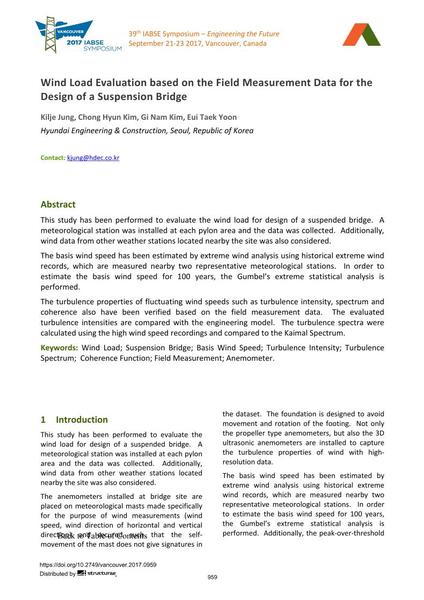Wind Load Evaluation based on the Field Measurement Data for the Design of a Suspension Bridge

|
|
|||||||||||
Bibliographic Details
| Author(s): |
Kilje Jung
(Hyundai Engineering & Construction, Seoul, Republic of Korea)
Chong Hyun Kim (Hyundai Engineering & Construction, Seoul, Republic of Korea) Gi Nam Kim (Hyundai Engineering & Construction, Seoul, Republic of Korea) Eui Taek Yoon (Hyundai Engineering & Construction, Seoul, Republic of Korea) |
||||
|---|---|---|---|---|---|
| Medium: | conference paper | ||||
| Language(s): | English | ||||
| Conference: | IABSE Symposium: Engineering the Future, Vancouver, Canada, 21-23 September 2017 | ||||
| Published in: | IABSE Symposium Vancouver 2017 | ||||
|
|||||
| Page(s): | 959-964 | ||||
| Total no. of pages: | 6 | ||||
| Year: | 2017 | ||||
| DOI: | 10.2749/vancouver.2017.0959 | ||||
| Abstract: |
This study has been performed to evaluate the wind load for design of a suspended bridge. A meteorological station was installed at each pylon area and the data was collected. Additionally, wind data from other weather stations located nearby the site was also considered. The basis wind speed has been estimated by extreme wind analysis using historical extreme wind records, which are measured nearby two representative meteorological stations. In order to estimate the basis wind speed for 100 years, the Gumbel’s extreme statistical analysis is performed. The turbulence properties of fluctuating wind speeds such as turbulence intensity, spectrum and coherence also have been verified based on the field measurement data. The evaluated turbulence intensities are compared with the engineering model. The turbulence spectra were calculated using the high wind speed recordings and compared to the Kaimal Spectrum. |
||||
| Keywords: |
suspension bridge wind load turbulence intensity Basis Wind Speed Turbulence Spectrum Coherence Function field measurement Anemometer
|
||||

